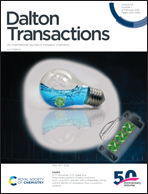Synthesis, characterization, and alkoxide transfer reactivity of dimeric Tl2(OR)2 complexes†
Abstract
Reaction of LiOCtBu2Ph with TlPF6 forms the dimeric Tl2(OCtBu2Ph)2 complex, a rare example of a homoleptic thallium alkoxide complex demonstrating formally two-coordinate metal centers. Characterization of Tl2(OCtBu2Ph)2 by 1H and 13C NMR spectroscopy and X-ray crystallography reveals the presence of two isomers differing by the mutual conformation of the alkoxide ligands, and by the planarity of the central Tl–O–Tl–O plane. Tl2(OCtBu2Ph)2 serves as a convenient precursor to the formation of old and new [M(OCtBu2Ph)n] complexes (M = Cr, Fe, Cu, Zn), including a rare example of T-shaped Zn(OCtBu2Ph)2(THF) complex, which could not be previously synthesized using more conventional LiOR/HOR precursors. The reaction of [Ru(cymene)Cl2]2 with Tl2(OCtBu2Ph)2 results in the formation of a ruthenium(II) alkoxide complex. For ruthenium, the initial coordination of the alkoxide triggers C–H activation at the ortho-H of [OCtBu2Ph] which results in its bidentate coordination. In addition to Tl2(OCtBu2Ph)2, related Tl2(OCtBu2(3,5-Me2C6H3))2 was also synthesized, characterized, and shown to exhibit similar reactivity with iron and ruthenium precursors. Synthetic, structural, and spectroscopic characterizations are presented.



 Please wait while we load your content...
Please wait while we load your content...